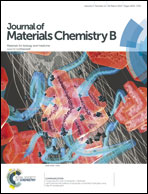Graphene oxide–coumarin derivative conjugate as activatable nanoprobe for intracellular imaging with one- or two-photon excitation†
Abstract
An interesting activatable fluorescent imaging probe based on a graphene oxide–coumarin derivative conjugate with high sensitivity in cancer cell visualization was proposed. The nanoprobe has a fluorescence off–on response for intracellular imaging via covalently linking coumarin derivatives to graphene oxide (GO) through disulfide bonds. The obtained nanoprobe shows no or weak fluorescence (OFF) most likely due to the fluorescence resonance energy transfer from the coumarin moiety to GO. It becomes activated (ON) inside the cells by glutathione initiated dissociation, showing remarkably enhanced fluorescence. More significantly, the present activatable nanoprobe can be efficiently taken up by cells. Two-photon induced fluorescence imaging of the proposed nanoprobe was also clearly observed by utilizing femtosecond pulse laser excitation, and affords a powerful alternative candidate for near-infrared (NIR) fluorescence imaging of tumors. Similar fluorescence was visualized in a tumor-bearing mouse model using this probe. These results demonstrate the potential of using this activatable nanoprobe for the detection of cancer.


 Please wait while we load your content...
Please wait while we load your content...